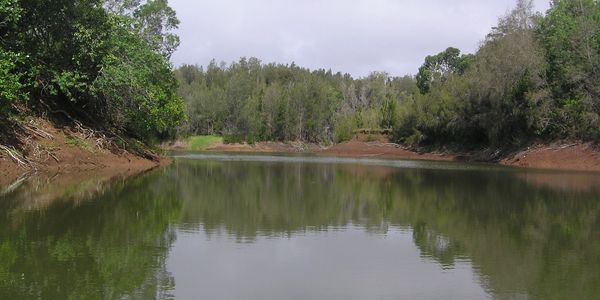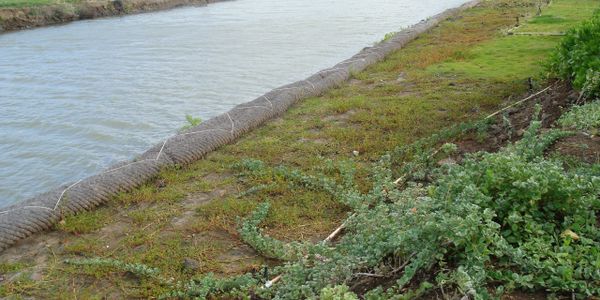NATURAL SYSTEMS ENGINEERING PROJECTS
SRGII provides clients with a suite of hydrological and ecological solutions using a natural systems approach. Our strengths include situational assessments of and engineering design support for wetland, stream, and watershed restoration and erosion control.
Erosion Assessment and Control, Marine Corps Base Hawai‘i
SRGII conducted a series of erosion assessment studies of Ulupa‘u Crater to delineate erosion hotspots and develop cost effective solutions to reduce and arrest erosion at specific sites. Recommended design solutions using best management practices, bio-engineering techniques and/or hardened structures are developed for hotspots. Implementation should lead to reduced erosion rates, control of storm water runoff, and filtered waters discharging into the ocean, thereby reducing the probability of potential compliance issues and long-term maintenance costs.
West Maui Agricultural Erosion Control, Hawaii Department of Health
SRGII conducted a systematic inventory assessment of roads and fields in the Agricultural District of the Kā‘anapali region of West Maui to catalogue conditions and rank and prioritize sites for treatment. Water quality improvements were achieved by installing a combination of management practices recommended in the Wahikuli-Honokōwai Watershed Based Plan to protect exposed surfaces, trap sediments, slow runoff, and promote vegetative cover, ultimately reducing the amount of sediment that enters the waterways and pollutes off-shore waters. Effectiveness monitoring was conducted to quantify the reduction in pollutant loading.
Wetland Feasibility Assessment, University of Hawai‘i

SRGII conducted a feasibility assessment for the construction of a wetland to reduce watershed impairments in the Lake Wilson watershed. The assessment included compiling technical, scientific, and legal information, as well as data sources that quantify water quality and quantity in order to identify impairments to the watershed. Alternative concept designs describing created wetlands to solve the impairments identified in the assessment were developed. Each alternative contains recommended design and siting parameters for a set of factors to be considered in the decision-making, design and construction processes.
Mōkapu Central Drainage Channel Improvements, Marine Corps Base Hawai‘i

SRGII developed the design criteria guidelines for this project that replaces a significantly more expensive, “hard” engineering design solution (i.e. concrete-lined channel) with a ‘natural systems’ engineering approach that will be aesthetically pleasing and attract native fauna to the area. The design uses features that are conducive to human use and viewshed values, physical habitat conducive to both flora and fauna of terrestrial and aquatic species, and pond areas that increase storage area and reduce the extent of floodwaters.
Honu‘apo Wetland Restoration Plan, Ka ‘Ohana O Honu‘apo

SRGII developed a wetland habitat restoration plan for Honu‘apo Estuary, an eight acre coastal wetland in the rural Ka‘ū District of Hawai‘i Island. Development of the plan included: a review of previous scientific, historical and archeological reports; site investigations; field surveys to document native species; and meetings soliciting input from agencies and community members. The plan describes the wetland ecohydrology, stressors, and restoration designs. It provides sufficient detail to guide a process that protects cultural and archeological resources and allows for appropriate passive recreational and educational uses. The plan outlines actions necessary to achieve the project goals, identifies necessary permits, and contains order of magnitude cost estimates.
Percolation Ditch Design, Marine Corps Base Hawai‘i

SRGII conducted a watershed assessment to help solve a chronic flooding problem resulting from inadequate drainage. The findings were used as the basis for a detailed design and construction plan and associated Environmental Assessment. The natural system design provides a cost savings compared to traditional engineering solutions, and allowed rapid approval of the project without numerous permits from regulatory agencies. The project protects wetland and ground water resources, and provides habitat for native water birds in the adjacent wildlife management area.
Expert Witness and Consultation, Moloka‘i
SRGII provided expert witness and consultation to attorneys representing a plaintiff who has brought a suit against adjacent property owners related to sediment discharge resulting in infrastructure damage. SRGII conducted technical analysis of the vegetation, erosion, and rainfall runoff regimes of the defendant’s property, prepared a report documenting the findings of our analysis, and served as an expert witness.
Contested Case Technical Support, O‘ahu
SRGII conducted a scientific engineering critique of reports and documents prepared in support of a multi-million dollar development plan. Our analysis reviewed the efficacy of outputs and conclusions made by consultants to the developer relating to quantity and quality of storm water runoff from proposed infrastructure improvements. SRGII testified on behalf of persons with standing in a contested case before the State.
SRGII: 111 Hekili Street, Suite A373, Kailua, HI 96734
Tel/Fax: 808-356-0552
